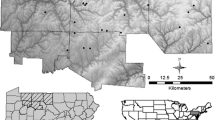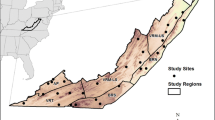Abstract
Selective herbivory can influence both spatial and temporal vegetation heterogeneity. For example, many northern European populations of free-ranging ungulates have reached unprecedented levels, which can influence plant species turnover, long-term maintenance of biodiversity and the subsequent stability of boreal ecosystems. However, the mechanisms by which large herbivores affect spatial and temporal vegetation heterogeneity remain poorly understood. Here, we combined a 10-year exclusion experiment with a herbivore intensity gradient to investigate how red deer (Cervus elaphus) acts as a driver of temporal and spatial heterogeneity in the understory of a boreal forest. We measured the two dimensions of heterogeneity as temporal and spatial species turnover. We found that temporal heterogeneity was positively related to herbivory intensity, and we found a similar trend for spatial heterogeneity. Removing red deer (exclosure) from our study system caused a distinct shift in species composition, both spatially (slow response) and temporally (quick response). Vegetation from which red deer had been excluded for 10 years showed the highest spatial heterogeneity, suggesting that the most stable forest understory will occur where there are no large herbivores. However, excluding red deer resulted in lower species diversity and greater dominance by a low number of plant species. If both stable but species rich ecosystems are the management goal, these findings suggest that naturally fluctuating, but moderate red deer densities should be sustained.




Similar content being viewed by others
References
Adler PB, Raff DA, Lauenroth WK (2001) The effect of grazing on the spatial heterogeneity of vegetation. Oecologia 128:465–479
Adrados C, Baltzinger C, Janeau G, Pepin D (2008) Red deer Cervus elaphus resting place characteristics obtained from differential GPS data in a forest habitat. Eur J Wildl Res 54:487–494. doi:10.1007/s10344-008-0174-y
Augustine DJ, McNaughton SJ (1998) Ungulate effects on the functional species composition of plant communities: herbivore selectivity and plant tolerance. J Wildl Manage 62:1165–1183. doi:10.2307/3801981
Austrheim G, Solberg EJ, Mysterud A (2011) Spatio-temporal variation in large herbivore pressure in Norway during 1949–1999: has decreased grazing by livestock been countered by increased browsing by cervids? Wildl Biol 17:286–298. doi:10.2981/10-038
Bakker C, Blair JM, Knapp AK (2003) Does resource availability, resource heterogeneity or species turnover mediate changes in plant species richness in grazed grasslands? Oecologia 137:385–391. doi:10.1007/s00442-003-1360-y
Bates D, Maechler M, Bolker B, Walker S (2014) lme4: Linear mixed-effects models using Eigen and S4. R package version 1.1-7. https://CRAN.R-project.org/package=lme4, pp
Beschta RL, Ripple WJ (2009) Large predators and trophic cascades in terrestrial ecosystems of the western United States. Biol Cons 142:2401–2414. doi:10.1016/j.biocon.2009.06.015
Côté SD, Rooney TP, Tremblay J-P, Dussault C, Waller DM (2004) Ecological impacts of deer overabundance. Annu Rev Ecol Evol Syst 35:113–147. doi:10.1146/annurev.ecolsys.35.021103.105725
Crawley MJ (2007) The R book. Wiley, Chichester
DeGabriel JL, Albon SD, Fielding DA, Riach DJ, Westaway S, Irvine RJ (2011) The presence of sheep leads to increases in plant diversity and reductions in the impact of deer on heather. J Appl Ecol 48:1269–1277. doi:10.1111/j.1365-2664.2011.02032.x
Elmqvist T, Folke C, Nystrom M, Peterson G, Bengtsson J, Walker B, Norberg J (2003) Response diversity, ecosystem change, and resilience. Front Ecol Envir 1:488–494. doi:10.2307/3868116
Fornara DA, du Toit JT (2007) Browsing lawns? Responses of Acacia nigrescens to ungulate browsing in an African savanna. Ecology 88:200–209. doi:10.1890/0012-9658(2007)88[200:blroan]2.0.co;2
Frelich LE, Lorimer CG (1985) Current and predicted long-term effects of deer browsing in hemlock forests in Michigan, USA. Biol Cons 34:99–120. doi:10.1016/0006-3207(85)90103-x
Fuller RJ, Gill RMA (2001) Ecological impacts of increasing numbers of deer in British woodland. Forestry 74:193–199. doi:10.1093/forestry/74.3.193
Gaston AJ, Stockton SA, Smith JL (2006) Species-area relationships and the impact of deer-browse in the complex phytogeography of the Haida Gwaii archipelago (Queen Charlotte Islands), British Columbia. Ecoscience 13:511–522. doi:10.2980/1195-6860(2006)13[511:sratio]2.0.co;2
Godvik IMR, Loe LE, Vik JO, Veiberg V, Langvatn R, Mysterud A (2009) Temporal scales, trade-offs, and functional responses in red deer habitat selection. Ecology 90:699–710. doi:10.1890/08-0576.1
Heckel CD, Bourg NA, McShea WJ, Kalisz S (2010) Nonconsumptive effects of a generalist ungulate herbivore drive decline of unpalatable forest herbs. Ecology 91:319–326. doi:10.1890/09-0628.1
Hegland SJ, Rydgren K (2016) Eaten but not always beaten: winners and losers along a red deer herbivory gradient in boreal forest. J Veg Sci 27:111–122. doi:10.1111/jvs.12339
Hegland SJ, Lilleeng MS, Moe SR (2013) Old-growth forest floor richness increases with red deer herbivory intensity. For Ecol Manag 310:267–274. doi:10.1016/j.foreco.2013.08.031
Hester AJ, Edenius L, Buttenschon RM, Kuiters AT (2000) Interactions between forests and herbivores: the role of controlled grazing experiments. Forestry 73:381–391. doi:10.1093/forestry/73.4.381
Hofmann RR (1989) Evolutionanry steps of ecophysiological adaptation and diversification of ruminants: a comparative view of their digestive-system. Oecologia 78:443–457. doi:10.1007/bf00378733
Hovick TJ, Elmore RD, Fuhlendorf SD, Engle DM, Hamilton RG (2015) Spatial heterogeneity increases diversity and stability in grassland bird communities. Ecol Appl 25:662–672. doi:10.1890/14-1067.1.sm
Jones CG, Lawton JH, Shachak M (1994) Organisms as ecosystem engineers. Oikos 69:373–386. doi:10.2307/3545850
Jost L (2006) Entropy and diversity. Oikos 113:363–375. doi:10.1111/j.2006.0030-1299.14714.x
Kindt R, Coe R (2005) Tree diversity analysis: a manual and software for common statistical methods for ecological and biodiversity studies. World Agroforestry Centre (ICRAF), Nairobi, Kenya
Koleff P, Gaston KJ, Lennon JJ (2003) Measuring beta diversity for presence-absence data. J Anim Ecol 72:367–382. doi:10.1046/j.1365-2656.2003.00710.x
Kuijper DPJ, Jędrzejewska B, Brzeziecki B, Churski M, Jędrzejewski W, Żybura H (2010) Fluctuating ungulate density shapes tree recruitment in natural stands of the Białowieża Primeval Forest, Poland. J Veg Sci 21:1082–1098. doi:10.1111/j.1654-1103.2010.01217.x
Kuznetsova A, Brockhoff PB, Christensen RHB (2015) lmerTest: Tests in Linear Mixed Effects Models. R package version 2.0, p 25
Legendre P, Legendre L (1998) Numerical ecology. Elsevier, Amsterdam
MacArthur RH, Wilson EO (1963) An equilibrium theory of insular zoogeography. Evolution 17:373–387. doi:10.2307/2407089
Mackey RL, Currie DJ (2001) The diversity-disturbance relationship: is it generally strong and peaked? Ecology 82:3479–3492. doi:10.1890/0012-9658(2001)082[3479:tddrii]2.0.co;2
May R (1974) Ecosystem patterns in randomly fluctuating environments. In: Rosen R, Snell F (eds) Progress in theoretical biology. Academic Press, New York, pp 1–50
Mori AS, Furukawa T, Sasaki T (2013) Response diversity determines the resilience of ecosystems to environmental change. Biol Rev 88:349–364. doi:10.1111/brv.12004
Mysterud A, Askilsrud H, Loe LE, Veiberg V (2010) Spatial patterns of accumulated browsing and its relevance for management of red deer Cervus elaphus. Wildl Biol 16:162–172. doi:10.2981/09-043
Nuttle T, Ristau TE, Royo AA (2014) Long-term biological legacies of herbivore density in a landscape-scale experiment: forest understoreys reflect past deer density treatments for at least 20 years. J Ecol 102:221–228. doi:10.1111/1365-2745.12175
Økland R (1990) Vegetation ecology: theory, methods and applications with reference to Fennoscandia. Sommerfeltia Suppl 1:1–233
Proulx M, Mazumder A (1998) Reversal of grazing impact on plant species richness in nutrient-poor vs. nutrient-rich ecosystems. Ecology 79:2581–2592. doi:10.1890/0012-9658(1998)079[2581:rogiop]2.0.co;2
R Core Team (2014) R: A language and environment for statistical computing. The R Foundation for Statistical Computing, Vienna, Austria
Rooney TP (2009) High white-tailed deer densities benefit graminoids and contribute to biotic homogenization of forest ground-layer vegetation. Plant Ecol 202:103–111. doi:10.1007/s11258-008-9489-8
Rydgren K (1993) Herb-rich spruce forests in W Nordland, N Norway: an ecological and methodological study. Nordic J Bot 13:667–690. doi:10.1111/j.1756-1051.1993.tb00112.x
Rydgren K, Økland RH, Hestmark G (2004) Disturbance severity and community resilience in a boreal forest. Ecology 85:1906–1915. doi:10.1890/03-0276
Sage JRW, Porter WF, Underwood HB (2003) Windows of opportunity: white-tailed deer and the dynamics of northern hardwood forests of the northeastern US. J Nat Conserv 10:213–220
Schütz M, Risch AC, Leuzinger E, Krusi BO, Achermann G (2003) Impact of herbivory by red deer (Cervus elaphus L.) on patterns and processes in subalpine grasslands in the Swiss National Park. For Ecol Manage 181:177–188. doi:10.1016/s0378-1127(03)00131-2
Sitters H, Di Stefano J, Christie F, Swan M, York A (2016) Bird functional diversity decreases with time since disturbance: does patchy prescribed fire enhance ecosystem function? Ecol Appl 26:115–127. doi:10.1890/14-1562
Skogen A, Lunde BN (1997) Flora og vegetasjon på Svanøy i Sunnfjord, med vegetasjonskart. Botanical Institute, University of Bergen, Norway
Soininen J (2010) Species turnover along abiotic and biotic gradients: patterns in space equal patterns in time? Bioscience 60:433–439. doi:10.1525/bio.2010.60.6.7
Steyaert S, Bokdam J, Braakhekke W, Findo S (2009) Endozoochorical plant seed dispersal by red deer (Cervus elaphus) in the Poľana Biosphere Reserve, Slovakia. Ekológia 28:191–205
Tanentzap AJ, Burrows LE, Lee WG, Nugent G, Maxwell JM, Coomes DA (2009) Landscape-level vegetation recovery from herbivory: progress after four decades of invasive red deer control. J Appl Ecol 46:1064–1072. doi:10.1111/j.1365-2664.2009.01683.x
Tremblay JP, Huot J, Potvin F (2006) Divergent nonlinear responses of the boreal forest field layer along an experimental gradient of deer densities. Oecologia 150:78–88. doi:10.1007/s00442-006-0504-2
van der Maarel E (1979) Transformation of cover-abundance values in phytosociology and its effects on community similarity. Vegetatio 39:97–114. doi:10.1007/BF00052021
Acknowledgments
This study was supported by the Norwegian Research Council under the Miljø 2015 programme (project number 204403/E40) and the Norwegian Environment Agency. Thanks to Norwegian Red Deer Centre and K.-K. Berget, P. Greve, I. G. Harstad, M. Knagenhjelm, T. R. Paulsen, T. Seldal, F. Solheim, T. Stokke, S. Vatne, V. Veiberg, T. Wiberg, K. F. Øi and H. Øyrehagen for their valuable help in the field. Sam Steyaert commented on drafts of the manuscript, and Peter Frost did copy editing. Thanks also to Mark Gillespie language help. We would like to thank the two anonymous reviewers for comments that helped improving the manuscript.
Author information
Authors and Affiliations
Corresponding author
Electronic supplementary material
Below is the link to the electronic supplementary material.
About this article
Cite this article
Lilleeng, M.S., Hegland, S.J., Rydgren, K. et al. Red deer mediate spatial and temporal plant heterogeneity in boreal forests. Ecol Res 31, 777–784 (2016). https://doi.org/10.1007/s11284-016-1391-6
Received:
Accepted:
Published:
Issue Date:
DOI: https://doi.org/10.1007/s11284-016-1391-6




